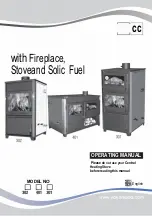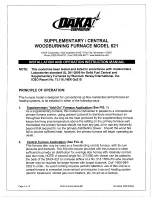
34
STANDING DOWN
There will be some point in the year
when you will not need to use your
stove for a considerable time and taking
care to clean it thoroughly then will
save you much time later. This is also a
good time to get your chimney swept
too as this will prevent any soot build
up from falling inside the stove ‘caking’
and blocking the flueway.
• Remove and clean any deposits from
the top of the baffle plate and check
for wear.
• Remove any debris and deposits from
the inside of the stove particularly at
the entrance to the flueway.
• Empty the ash pan and thoroughly
clean out the ash pan chamber.
• Check the rope seal and replace
damaged ropes that do not provide a
good seal – see page 37
.
• Check any fire cement bonds around
the flue joints, particularly where they
connect to the stove. Remove any loose
cement and re-seal.
• Check the vermiculite firebricks and
replace any that are becoming very thin
or have crumbled to reveal the cast iron
sides of the stove.
• Check the grate for signs of wear.
Excessive wear, such as grate bars or
log retaining bars which are bent or
warped, could be an indication of
over-firing or using inappropriate fuels
such as petroleum coke. Order genuine
replacement components from your
authorised Hi-Flame dealer (or in case
of difficulty your National Distributor)
– see page back cover.
ROUTINE MAINTENANCE
Please note: In line with other stove
manufacturers, Hi-Flame baffle plates,
fire grates and firebricks are regarded
as ‘consumable’ items and are therefore
not covered under your warranty – for
full warranty details please refer to
page 38. Only use genuine Hi-Flame
replacement parts which you can buy
from your approved Hi-Flame stockist.
• Cleaning the Baffle Plate
and Flueway
During the heating season check the
flueway and baffle plate at least once
a month to start with and remove any
soot deposits. Should these be
excessive then have your chimney and
flue cleaned. At the same time review
your choice of fuel and the way that
you operate the stove.
Regular long periods of slow or over-
night burning can create excessive soot
because the stove is not operating at
the temperature required to burn off
most of the sooty. Damp or unseasoned
wood will also have similar effect.
To find a local registered sweep visit
the National Association of Chimney
Sweeps (NACS)
www.nacs.org.uk
or a
similar professional body.
• Removing or replacing the
baffle plate
In order to remove the baffle plate,
the firebricks need to be removed to
provide space to manoeuvre the baffle
plate downwards and outwards. See
page 35 opposite on how to remove
the firebricks.
1
Remove all the firebricks and inspect
Summary of Contents for HF217-SE Baby Gabriel
Page 2: ......
Page 7: ...7 GENERAL DIMENSIONS 414 435 555 95 134 345 134 125 ø All dimensions are in mm ...
Page 43: ......











































